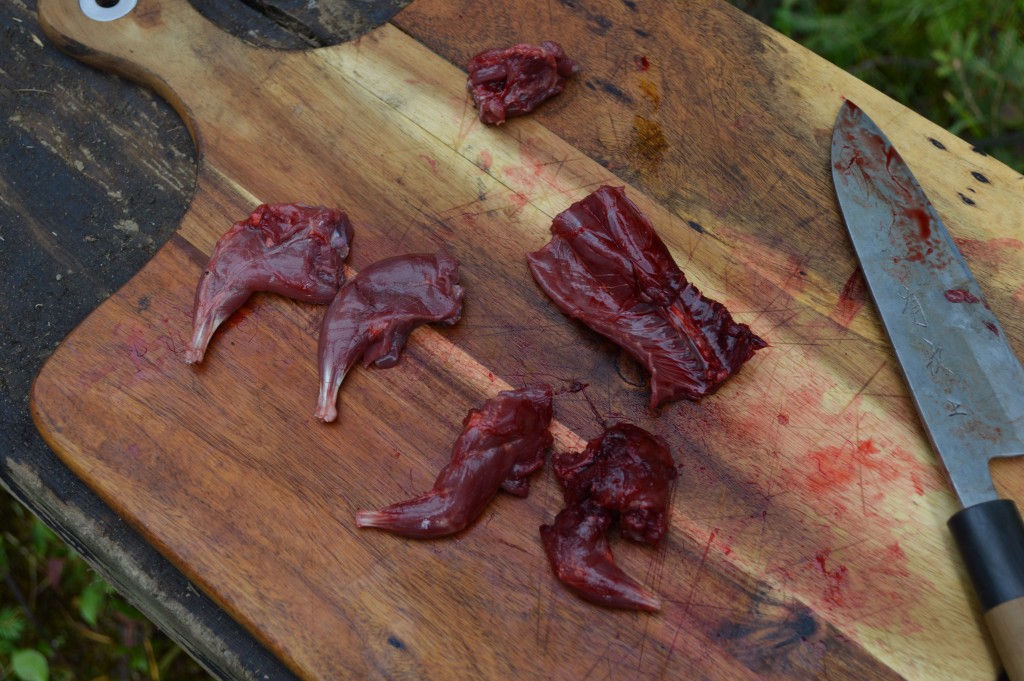 Last week I went on a hunting trip with Kevin, and I shot and killed my first animal. It was a squirrel.
Last week I went on a hunting trip with Kevin, and I shot and killed my first animal. It was a squirrel.
I know: that’s not very impressive. I’m sure most boys who grow up in the country have done this by age ten. And I know: you think squirrel is something that only hillbillies or starving back-country adventurers eat. Actually it’s pretty tasty.
Once skinned, gutted, and cleaned, the squirrel carcass looked very much like a tiny rabbit. The meat was shockingly dark. I thought that a small critter with such rapid, twitching movements would have light meat.
The cleaned carcass:

I divided the squirrel that same way I would a rabbit: into forequarters, a saddle, and hindquarters.

I … Continue reading.
 Last November we started getting game birds, chiefly grouse and pheasant, from Mr. McLarney, who hunts them with his English pointer. In exchange for the wild poultry, I provide Mrs. McLarney with a recipe for their preparation.
Last November we started getting game birds, chiefly grouse and pheasant, from Mr. McLarney, who hunts them with his English pointer. In exchange for the wild poultry, I provide Mrs. McLarney with a recipe for their preparation.
Cooking grouse and pheasant is fairly new to me, and I’m still figuring out the whole hanging-plucking-gutting-cooking thing.
From the cook’s perspective, the ideal game bird (or rabbit) is shot cleanly in the head. That way there’s no shot hidden in the meat. You get a higher yield, and diners won’t unwittingly bite down on a piece of lead. I have very little experience with guns, but apparently getting that head shot is relatively easy when the slow-witted bird is standing on the … Continue reading.
Step One: Acquire Grouse
A friend’s father, Mr. McLarney, hunts game birds with his English pointer. I had never, not once, paused to consider the signficance of common canine descriptors like pointer, setter, and retriever, until Mr. McLarney’s hunts were explained to me. The dog walks a ways in front of him, and when it comes upon a bird it stops and “points”: it aims its snout at the prey. Mr. McLarney moves within range and readies his gun, then makes a call to the pointer. At the signal, the dog scares the bird into flight, so that Mr. McLarney can pull it from the sky with his shotgun.[1]
Mr. McLarney trained his pointer in his backyard with a … Continue reading.
 This week I had the opportunity to cook with pig’s blood. There’s actually more classical applications for blood than you may think.
This week I had the opportunity to cook with pig’s blood. There’s actually more classical applications for blood than you may think.
Fresh blood has a beautiful colour, similar to red wine, but with an opalescent sheen. When heated, the blood turns burgundy, then brown, and eventually black. It coagulates somewhere around 75°C, which makes it ideal for thickening liquids.
Civet: A Gateway Dish
If you’re at all squeamish about cooking with blood, this is probably a good dish to start with.
The two things that make a civet a civet are: one, that game is marinated in wine which is later used to braise the meat; and two, that the braising liquid is thickened with blood and used as … Continue reading.
The personal website of Edmonton chef Allan Suddaby
 Last week I went on a hunting trip with Kevin, and I shot and killed my first animal. It was a squirrel.
Last week I went on a hunting trip with Kevin, and I shot and killed my first animal. It was a squirrel.


